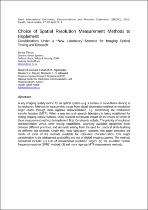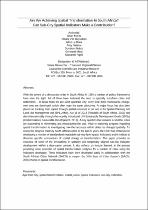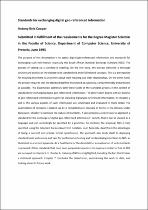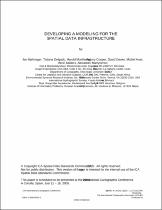 ResearchSpace
ResearchSpace
Choice of spatial resolution measurement methods to implement: considerations under a “New Laboratory”-scenario for imaging optical testing and research
JavaScript is disabled for your browser. Some features of this site may not work without it.
- ResearchSpace
- →
- Research Publications/Outputs
- →
- Conference Publications
- →
- View Item
| dc.contributor.author |
Theron, Bertus

|
|
| dc.contributor.author |
El-Desouki, M

|
|
| dc.contributor.author |
Aljekhedab, FMR

|
|
| dc.contributor.author |
Alayed, MSI

|
|
| dc.contributor.author |
Alsawad, MSD

|
|
| dc.date.accessioned | 2014-06-17T09:58:58Z | |
| dc.date.available | 2014-06-17T09:58:58Z | |
| dc.date.issued | 2013-04 | |
| dc.identifier.citation | Theron, B, El-Desouki, M, Aljekhedab, F.M.R, Alayed, M.S.I and Alsawad, M.S.D. 2013. Choice of spatial resolution measurement methods to implement: considerations under a “New Laboratory”-scenario for imaging optical testing and research. In: Saudi International Electronics, Communications and Photonics Conference (SIECPC), 2013, Riyadh, Saudi Arabia, 27-30 April 2013 | en_US |
| dc.identifier.uri | http://hdl.handle.net/10204/7448 | |
| dc.description | Saudi International Electronics, Communications and Photonics Conference (SIECPC), 2013, Riyadh, Saudi Arabia, 27-30 April 2013 | en_US |
| dc.description.abstract | A key imaging quality metric for an optical system (e.g. a camera or surveillance device) is its resolution. Methods to measure this, range from visual observation methods on resolution target charts, through more rigorous characterization, e.g. determining the modulation transfer function (MTF). When a new test-and-research laboratory is being established for testing imaging optical systems, some practical constraints impact on the choice of which of these measurement methods to implement first. Constraints include: The priority of resolution characterization versus other testing capabilities, balancing available equipment funds between different priorities, and demands arising from the need for practical skills-building on different test methods. Under this “new laboratory” scenario, this paper considers the merits of some of the methods available for resolution characterization. One major consideration is the widespread availability and use of digital imaging systems. The methods considered include: (1) Use of conventional resolution targets, (2) the so-called “spatial frequency response (SFR)” method, (3) and more rigorous MTF measurement methods. | en_US |
| dc.language.iso | en | en_US |
| dc.relation.ispartofseries | Workflow;12713 | |
| dc.subject | Imaging optics | en_US |
| dc.subject | Surveillance devices | en_US |
| dc.subject | Image quality | en_US |
| dc.subject | Spatial resolution | en_US |
| dc.subject | Spatial frequency | en_US |
| dc.subject | Cut-off frequency | en_US |
| dc.subject | Limiting frequency | en_US |
| dc.subject | Modulation transfer function | en_US |
| dc.subject | MTF | en_US |
| dc.subject | Spatial resolution measurement methods | en_US |
| dc.subject | Digital imaging | en_US |
| dc.subject | Spatial frequency response | en_US |
| dc.subject | Slanted edge method | en_US |
| dc.title | Choice of spatial resolution measurement methods to implement: considerations under a “New Laboratory”-scenario for imaging optical testing and research | en_US |
| dc.type | Conference Presentation | en_US |
| dc.identifier.apacitation | Theron, B., El-Desouki, M., Aljekhedab, F., Alayed, M., & Alsawad, M. (2013). Choice of spatial resolution measurement methods to implement: considerations under a “New Laboratory”-scenario for imaging optical testing and research. http://hdl.handle.net/10204/7448 | en_ZA |
| dc.identifier.chicagocitation | Theron, B, M El-Desouki, FMR Aljekhedab, MSI Alayed, and MSD Alsawad. "Choice of spatial resolution measurement methods to implement: considerations under a “New Laboratory”-scenario for imaging optical testing and research." (2013): http://hdl.handle.net/10204/7448 | en_ZA |
| dc.identifier.vancouvercitation | Theron B, El-Desouki M, Aljekhedab F, Alayed M, Alsawad M, Choice of spatial resolution measurement methods to implement: considerations under a “New Laboratory”-scenario for imaging optical testing and research; 2013. http://hdl.handle.net/10204/7448 . | en_ZA |
| dc.identifier.ris | TY - Conference Presentation AU - Theron, B AU - El-Desouki, M AU - Aljekhedab, FMR AU - Alayed, MSI AU - Alsawad, MSD AB - A key imaging quality metric for an optical system (e.g. a camera or surveillance device) is its resolution. Methods to measure this, range from visual observation methods on resolution target charts, through more rigorous characterization, e.g. determining the modulation transfer function (MTF). When a new test-and-research laboratory is being established for testing imaging optical systems, some practical constraints impact on the choice of which of these measurement methods to implement first. Constraints include: The priority of resolution characterization versus other testing capabilities, balancing available equipment funds between different priorities, and demands arising from the need for practical skills-building on different test methods. Under this “new laboratory” scenario, this paper considers the merits of some of the methods available for resolution characterization. One major consideration is the widespread availability and use of digital imaging systems. The methods considered include: (1) Use of conventional resolution targets, (2) the so-called “spatial frequency response (SFR)” method, (3) and more rigorous MTF measurement methods. DA - 2013-04 DB - ResearchSpace DP - CSIR KW - Imaging optics KW - Surveillance devices KW - Image quality KW - Spatial resolution KW - Spatial frequency KW - Cut-off frequency KW - Limiting frequency KW - Modulation transfer function KW - MTF KW - Spatial resolution measurement methods KW - Digital imaging KW - Spatial frequency response KW - Slanted edge method LK - https://researchspace.csir.co.za PY - 2013 T1 - Choice of spatial resolution measurement methods to implement: considerations under a “New Laboratory”-scenario for imaging optical testing and research TI - Choice of spatial resolution measurement methods to implement: considerations under a “New Laboratory”-scenario for imaging optical testing and research UR - http://hdl.handle.net/10204/7448 ER - | en_ZA |








